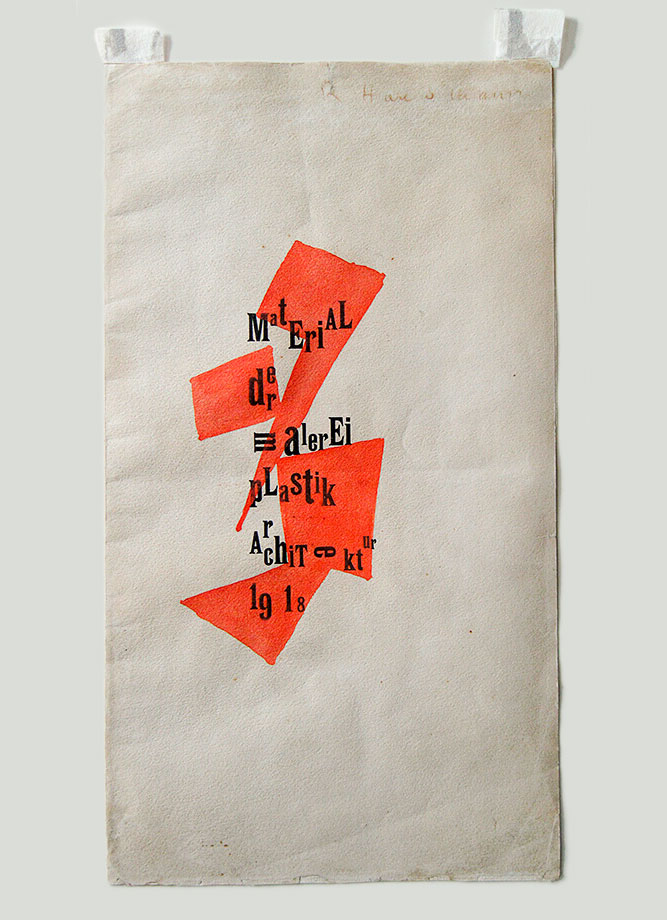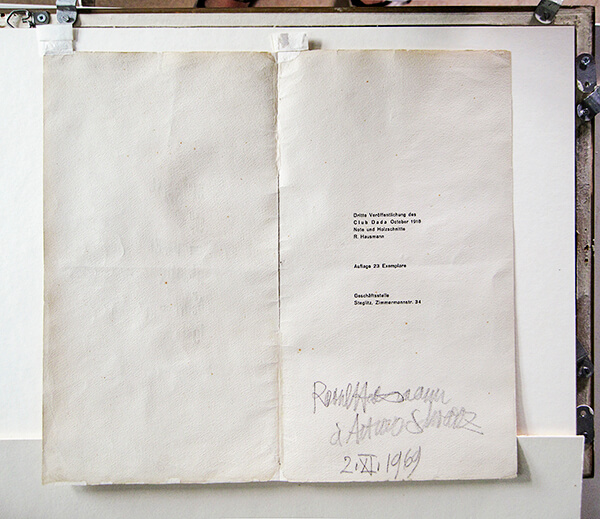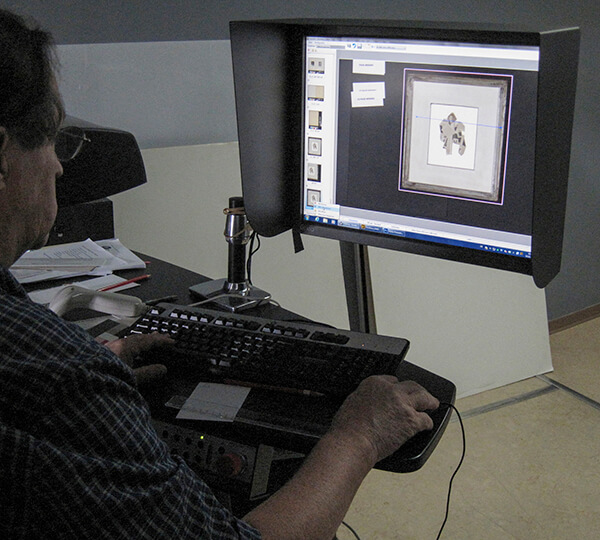Fragile Works in the Digital Age
With around 720 artworks and historic documents the Kunsthaus Zurich holds one of the world’s most extensive Dada collections: paintings, sculptures, photographs, works on paper, letters, notes, books, magazines, flyers, posters and manuscripts. To mark 100 years of the Dada movement, all the documents and works on paper have been digitized, and in some cases restored, to make them accessible to a global audience.
The project has been made possible thanks to support from the Ernst Göhner Foundation, Helvetia Insurance and the Federal Office of Culture FOC. The technical implementation of the digitization has been carried out by the Zentralbibliothek (Central Library) in Zurich.

Raoul Hausmann, cover design for Material der Malerei, Plastik, Architektur, 1918
Gr.Inv. 1980/92

Raoul Hausmann, cover design for Material der Malerei, Plastik, Architektur, 1918, Gr.Inv. 1980/92, deframed

Raoul Hausmann, cover design for Material der Malerei, Plastik, Architektur, 1918, Gr.Inv.1980/92, deframed, opened

Raoul Hausmann, cover design for Material der Malerei, Plastik, Architektur, 1918, Gr.Inv.1980/92, deframed, back

Scanned Collage Dada, (Portrait Raoul Hausmann), 1919/1920 by Johannes Baader (Gr.Inv. 1989/1)

Removing an illustration for Material der Malerei, Plastik, Architektur (1918) by Raoul Hausmann (Gr.Inv. 1980/95) from its frame

Scanned collage (1919) by Hans Arp, (Gr.Inv. 1980/107), Photo: Kunsthaus Zürich, Work © 2015 ProLitteris, Zurich

Restorer Jean Rosston removing a work from its frame, Photo: Kunsthaus Zürich
The Collection of Prints and Drawings and the Library
The Collection of Prints and Drawings and the Library
Within the Dada collection the two largest groups are the approximately 180 works in the Collection of Prints and Drawings, and 540 Dadaist publications and documents in the library. The library also collects research literature on Dada. The original publications and documents of the historical Dada movement as well as the research literature are fully indexed in the library’s online catalogue. The works on paper from the Collection of Prints and Drawings are als published online continuously.
Publicize, promote research, conserve
Publicize, promote research, conserve
The digitization project, in which the restoration department and the library are heavily involved, is being overseen by curator Cathérine Hug supported by Dada specialist Raimund Meyer. There are a number of reasons for the digitization. Strong interest in Dada around the world means that the artworks and documents are frequently lent out to exhibitions at museums in Switzerland and abroad. However, because paper was often of very poor quality in the early 20th century, and especially during the First World War, many of the originals are in fragile condition. For this reason, restrictions have to be placed on their use. In some critical cases, these irreplaceable objects cannot withstand any further wear. To promote future research internationally without the need to move the fragile originals and expose them to the bleaching effect of light, documents of more than one page have been digitized in their entirety – and not just the title page, as is common practice in many places. For the museum itself, the digitization project is an opportunity to compile up-to-date condition reports, collate new findings and initiate conservation measures where necessary.
Focus on the essence
Focus on the essence
The historical Dada movement lasted barely a decade; but the artists dubbed ‘Dadaists’ remained active after the period from 1916 to 1925 and lived on into the second half of the 20th century. To maintain a focus on the core of Dada, however, the Kunsthaus team working with Cathérine Hug and Raimund Meyer have limited their work to specific time periods. The digitization project covers all the original documents – magazines, manuscripts, vintage photographs, autographs and typescripts – created between 1916 and 1925, together with books and exhibition catalogues from the early days of the movement through to around 1950. It does neither include reprints and secondary literature nor paintings, reliefs and sculptures. The holdings of drawings and prints from the precursors in the 1910s through to the final offshoots in the 1925s have been digitized in full, too.
Digitization and restoration process
Digitization and restoration process
The Kunsthaus Zürich has scanned large parts of its Dada collection in close collaboration with the Digitization Center (DigiZ) of the Zentralbibliothek Zürich. Its head, Peter Moerkerk, has digitized thousands of pages of texts and images in first-rate quality in the Center’s rooms together with the paper restorer Jean Rosston and the head of the Kunsthaus Library Thomas Rosemann.
Decisive for this choice were the Digitization Center’s many years of experience in handling valuable documents. The Center can rely on state-of-the-art scanners and the most recent equipment—a key prerequisite for optimal scans considering the wide range of media and different documents of the Dada collection. The i2s, Rencay and Microbox high-end scanners used guarantee a gentle scanning process with a variable opening angle (30°–180°) in best colour quality.
All the texts have been scanned in their entirety, including covers, spines and backs. A single volume may contain anything from a few dozen to several hundred pages, so the aim is to ensure that they will not need to be digitized again in the near future. Once the hue and brightness have been corrected to the best possible approximation of the original, they are therefore being saved as very high resolution TIFF files at 400 dpi. Many texts are intended to be used via OCR for easy content searches and manual commenting. Documentation on the restoration process is available on the website of the conservation and restoration department, where Jean Rosston describes the challenges involved.

Staff member of the Zentralbibliothek Zürich at a Book2net Cobra 90 V Scanner

Staff member of the Zentralbibliothek Zürich at an i2s Quartz A1 Scanner
Presentation online and in exhibitions
Presentation online and in exhibitions
Dada on Paper presents a selection of the highlights from the Dada collection of the Kunsthaus Zurich, with introductions written by Raimund Meyer. The end of the year 2016 of the Dada-centennial marks the beginning for the digitized material being all published online continuously. Some of the restored originals have been displayed in two exhibitions that curator Cathérine Hug co-curated for the anniversary year: Dadaglobe Reconstructed (5 February to 1 May 2016) and Francis Picabia. A Retrospective (3 June to 25 September 2016). Following their premiere in Zurich, both were shown at the Museum of Modern Art in New York. In addition, the exhibition Supplément Dada (20 May to 24 July 2016) included numerous restored artworks.